Makindo Medical Notes"One small step for man, one large step for Makindo" |
|
|---|---|
| Download all this content in the Apps now Android App and Apple iPhone/Pad App | |
| MEDICAL DISCLAIMER: The contents are under continuing development and improvements and despite all efforts may contain errors of omission or fact. This is not to be used for the assessment, diagnosis, or management of patients. It should not be regarded as medical advice by healthcare workers or laypeople. It is for educational purposes only. Please adhere to your local protocols. Use the BNF for drug information. If you are unwell please seek urgent healthcare advice. If you do not accept this then please do not use the website. Makindo Ltd. |
Pulmonary Embolism (PE)
-
| About | Anaesthetics and Critical Care | Anatomy | Biochemistry | Cardiology | Clinical Cases | CompSci | Crib | Dermatology | Differentials | Drugs | ENT | Electrocardiogram | Embryology | Emergency Medicine | Endocrinology | Ethics | Foundation Doctors | Gastroenterology | General Information | General Practice | Genetics | Geriatric Medicine | Guidelines | Haematology | Hepatology | Immunology | Infectious Diseases | Infographic | Investigations | Lists | Microbiology | Miscellaneous | Nephrology | Neuroanatomy | Neurology | Nutrition | OSCE | Obstetrics Gynaecology | Oncology | Ophthalmology | Oral Medicine and Dentistry | Paediatrics | Palliative | Pathology | Pharmacology | Physiology | Procedures | Psychiatry | Radiology | Respiratory | Resuscitation | Rheumatology | Statistics and Research | Stroke | Surgery | Toxicology | Trauma and Orthopaedics | Twitter | Urology
🫁 Pulmonary emboli should be prevented by early mobilisation and low-dose LMWH in all at-risk patients. ⚠️ Untreated mortality is ~30%, which falls to ~8% with treatment.
🚑 Initial Pulmonary Embolism (PE) Management
| ⚕️ Stepwise Management of Suspected PE |
|---|
|
📖 About
- In-hospital prevention is vital (VTE prophylaxis).
- Occurs in ~15–20/1000 inpatients; 2–5 are fatal.
- Always calculate and document Wells score.
⚠️ Risks for VTE
- Major trauma, surgery, immobility, joint replacement, spinal cord injury
- Active cancer (esp. pancreas, lung, gastric, brain, haematological)
- OCPs, HRT (↑ risk x2–6)
- Inherited thrombophilia (Protein C/S deficiency, Factor V Leiden)
- Obesity, smoking, hypertension, diabetes, hypercholesterolaemia
- Central venous lines, infections, blood transfusions
- MI, heart failure
🔬 Pathophysiology
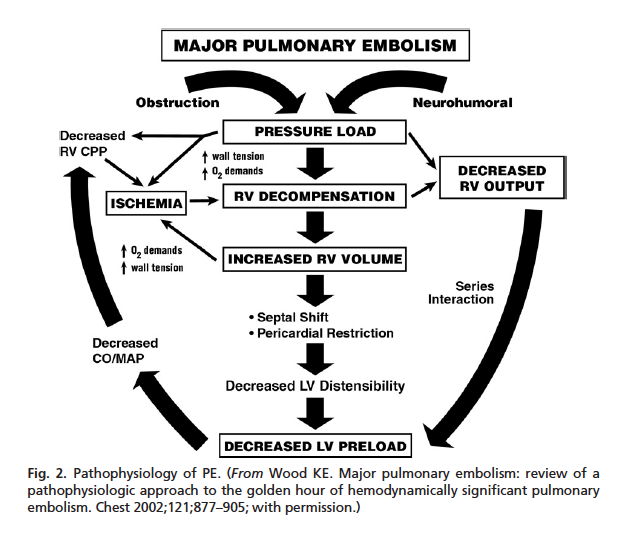
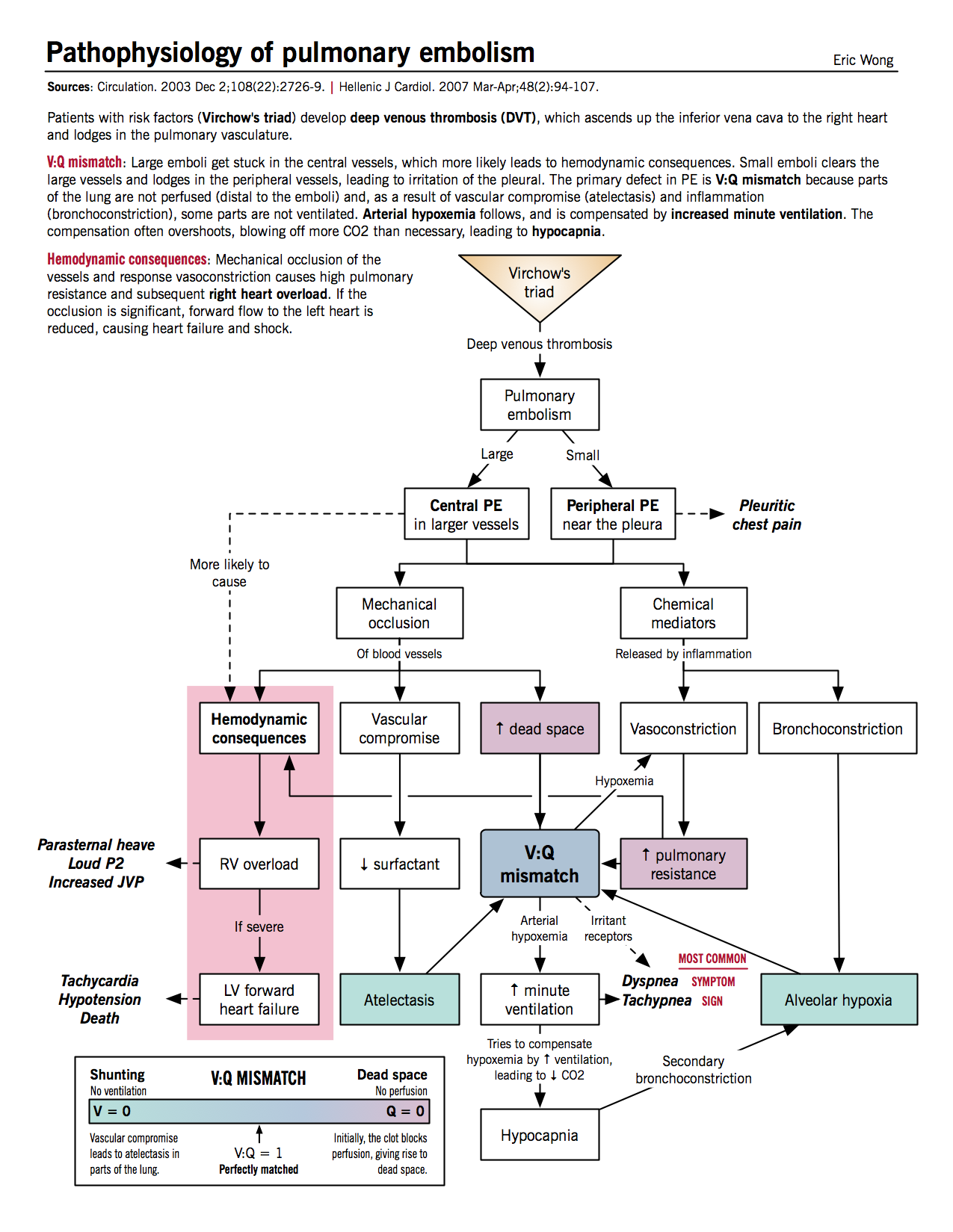
🩺 Clinical Features
- Vitals: Tachycardia, hypoxia, hypotension, raised JVP, loud P2
- Small PE: Often subtle, confusion in elderly, can lead to chronic pulmonary HTN
- Medium PE: Dyspnoea, pleuritic pain, haemoptysis, pleural rub
- Large PE: Acute RHF → dyspnoea, syncope/collapse (often in toilet), chest pain
- Massive PE: Sudden cardiac death
- Paradoxical embolism: Via PFO → stroke, gut or limb infarction
🔍 Investigations
- Bloods: FBC, U&E, LFT (usually normal), CRP
- ABG: Hypoxia, low/normal CO₂ (Type 1 RF)
- D-dimer: High sensitivity, low specificity
- ECG: Sinus tachycardia most common. S1Q3T3, RV strain, new AF, RBBB
- CXR: Often normal. May show effusion, infarction, Westermark sign, Palla sign
- Troponin: Elevated in 30–50% of large PE
- Echo: RV dilatation, TR, pulmonary HTN, RH strain
- USS legs: Proximal DVT → treat as PE equivalent
- V/Q scan: Useful in pregnancy, abnormal if mismatch present
- CTPA: First-line in most centres, rapid & specific
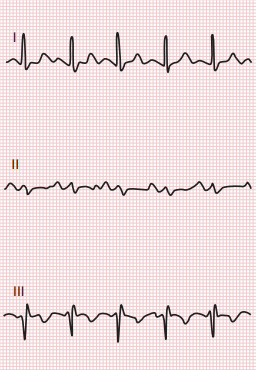
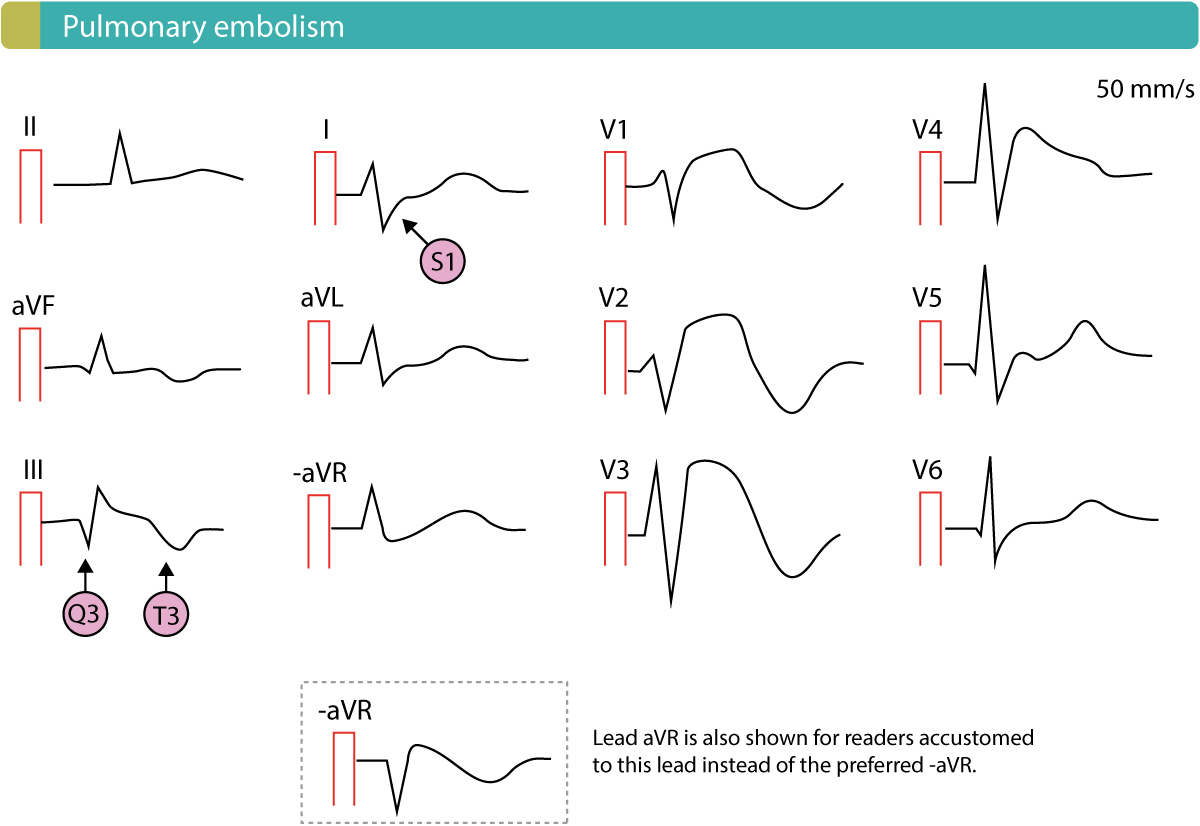
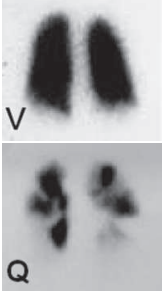
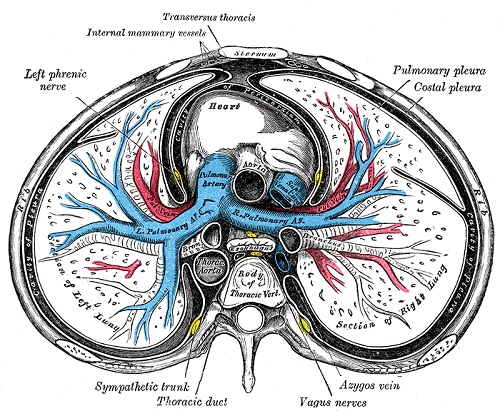
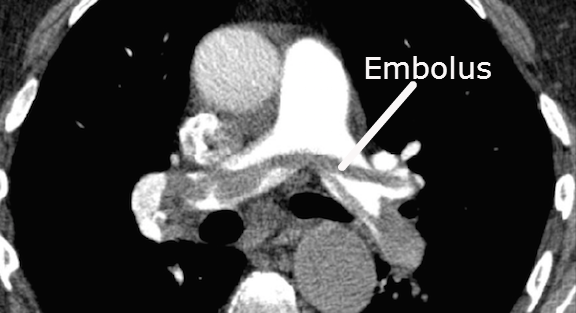
🧾 Differential Diagnosis
- Septic emboli (IVDU, tricuspid endocarditis)
- Fat embolism (fracture)
- Air embolism (IV lines, diving)
- Amniotic fluid embolism (post-partum)
- Malignancy-related emboli
📊 Wells Criteria for PE
| Criteria | Points |
|---|---|
| Clinical signs of DVT | +3 |
| PE most likely diagnosis | +3 |
| HR > 100 bpm | +1.5 |
| Immobilisation ≥3 days or surgery <4 weeks | +1.5 |
| Previous DVT/PE | +1.5 |
| Haemoptysis | +1 |
| Active malignancy | +1 |
| Interpretation | |
| Score ≥ 4 → PE likely → Imaging (CTPA)
Score < 4 → PE unlikely → D-dimer first |
|
Related Subjects: | Pulmonary Embolism | Wells Score for PE
🫁 Pulmonary Embolism Rule-out Criteria (PERC) Score
The PERC score is a validated clinical decision tool used in the emergency setting to safely exclude pulmonary embolism (PE) in low-risk patients without the need for further testing (like D-dimer or imaging). 👉 If all 8 criteria are negative and clinical suspicion is low (<15%), the risk of PE is <2% — no further workup is needed.
📋 PERC Criteria (8 Components)
| Criterion | Threshold |
|---|---|
| Age | < 50 years |
| Heart rate | < 100 bpm |
| Oxygen saturation (room air) | > 94% |
| Unilateral leg swelling | Absent |
| Haemoptysis | Absent |
| Recent trauma or surgery | None within 4 weeks |
| Previous PE or DVT | Absent |
| Exogenous oestrogen use | Absent (e.g., OCP, HRT) |
✅ How to Use
- Step 1: Assess pre-test probability of PE using gestalt/Wells score. PERC is only valid in low pre-test probability (<15%).
- Step 2: Apply the 8 PERC criteria. If all 8 are negative → PE can be safely excluded, no D-dimer or imaging required.
- Step 3: If any criterion is positive → further testing needed (start with D-dimer).
⚠️ Limitations
- Not valid in moderate/high suspicion patients.
- Not validated in inpatients, pregnancy, or those with significant comorbidities.
- Use alongside clinical judgement — never replace it.
🧠 Teaching Commentary
The PERC score is about avoiding over-investigation. CT pulmonary angiography carries radiation and contrast risks, so PERC helps reduce unnecessary scans in genuinely low-risk patients. - Remember: PERC is applied after clinical assessment shows a low pre-test probability. - If your patient is “PERC-negative,” their risk of PE is so low that you can stop without further testing. - If “PERC-positive” (fails even one criterion), you must escalate to D-dimer (and possibly imaging).
Related Subjects: | Pulmonary Embolism | PERC Score | Wells Score for PE
🫁 Pulmonary Embolism Severity Index (PESI)
The PESI score predicts 30-day mortality in patients with confirmed PE. It helps decide who is safe for outpatient anticoagulation vs who needs hospital admission / escalation.
📋 PESI Variables & Points
| Variable | Points |
|---|---|
| Age | +1 per year |
| Male sex | +10 |
| Cancer | +30 |
| Heart failure | +10 |
| Chronic lung disease | +10 |
| Pulse ≥110 | +20 |
| Systolic BP <100 mmHg | +30 |
| Respiratory rate ≥30 | +20 |
| Temperature <36°C | +20 |
| Altered mental status | +60 |
| O₂ saturation <90% | +20 |
📊 PESI Risk Classes
| Class | Score | Risk | 30-day Mortality |
|---|---|---|---|
| I | ≤65 | Very Low | ~1.1% |
| II | 66–85 | Low | ~3.1% |
| III | 86–105 | Intermediate | ~6.5% |
| IV | 106–125 | High | ~10.4% |
| V | >125 | Very High | ~24.5% |
🩺 Simplified PESI (sPESI)
A quicker bedside version. Each item = 1 point. sPESI = 0 → Low risk (30-day mortality ~1%).
| Variable | Points |
|---|---|
| Age >80 years | +1 |
| Cancer | +1 |
| Chronic cardiopulmonary disease | +1 |
| Pulse ≥110 | +1 |
| Systolic BP <100 mmHg | +1 |
| O₂ saturation <90% | +1 |
✅ Clinical Use
- PESI Class I–II / sPESI = 0: Low risk → consider outpatient anticoagulation if safe.
- PESI Class III–V / sPESI ≥1: Higher risk → admit for monitoring, consider escalation if haemodynamically unstable.
🧠 Teaching Commentary
- PERC / Wells / Geneva = diagnostic (before imaging). - PESI / sPESI = prognostic (after PE is confirmed). PESI highlights that not all PEs are equal — some are low-risk clots suitable for ambulatory care, others are life-threatening. 👉 In practice: sPESI is quicker and widely used in the ED/acute medical unit.
💊 Management
- High-flow O₂, cardiac monitoring
- Stable PE: Wells + D-dimer/CTPA pathway. Anticoagulate early if high suspicion.
- Unstable PE: Oxygen, cautious fluids, vasopressors, thrombolysis (Alteplase 10 mg bolus + 90 mg/2h)
- Cardiac arrest (PEA): Suspect PE if very low ETCO₂. Give thrombolysis, continue CPR 60–90 min
- Interventions: Catheter-directed thrombolysis or surgical embolectomy if thrombolysis fails or contraindicated
- Anticoagulation: LMWH, UFH, or DOAC (Apixaban/Rivaroxaban). Warfarin 3–6 months for first unprovoked PE
- IVC filter: For contraindication to anticoagulation or recurrent PE despite therapy
🎯 Special Scenarios
- Cancer: Prefer DOACs (Apixaban, Rivaroxaban) but caution in GI malignancy
- Pregnancy: – CXR safe – USS Doppler first-line – V/Q or CTPA if needed – LMWH mainstay (Warfarin contraindicated) – Double dose Enoxaparin due to ↑ GFR
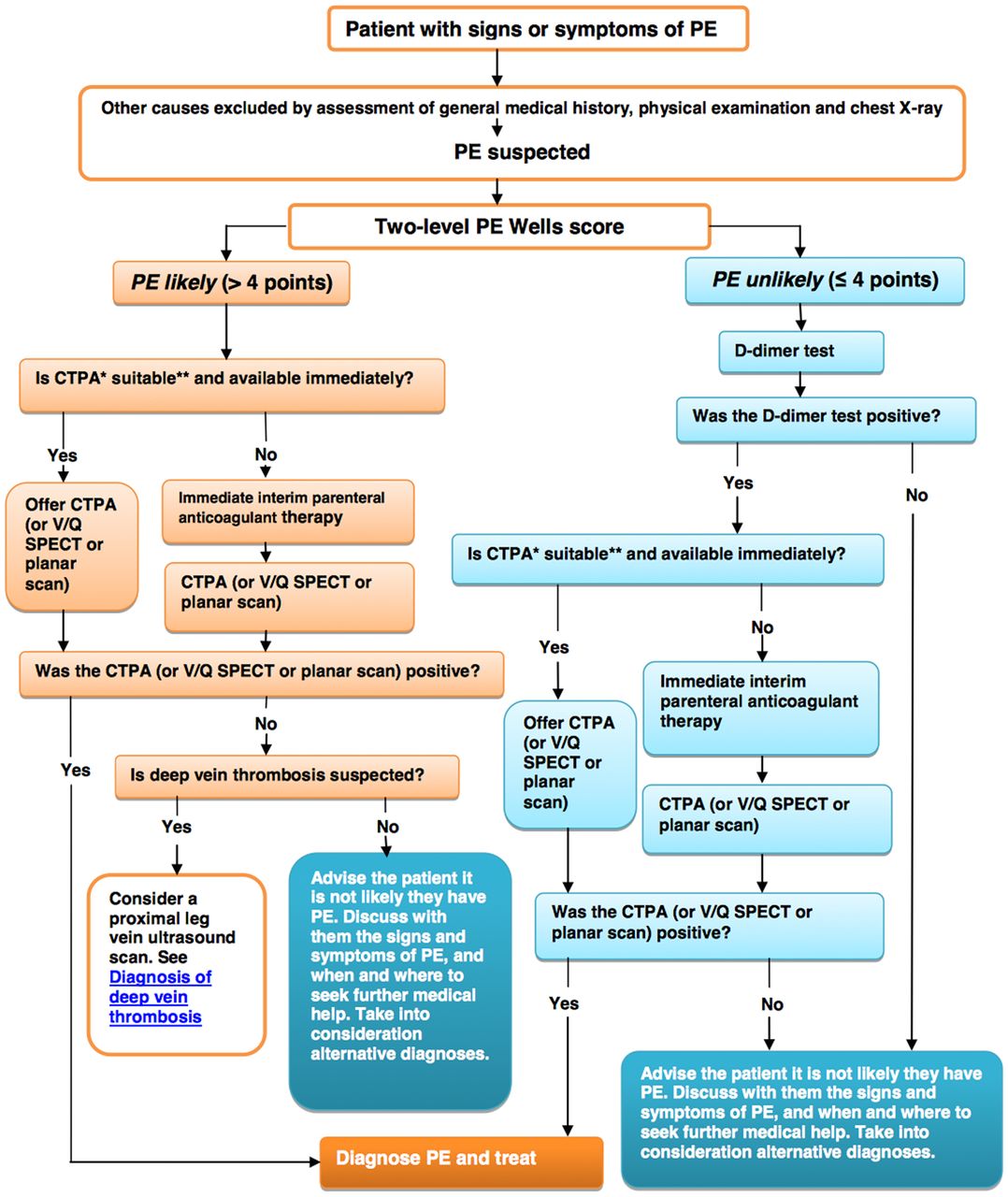
📚 References
Cases — Pulmonary Embolism (PE)
- Case 1 — Post-Operative PE 🏥: A 62-year-old woman, 7 days after hip replacement, develops sudden pleuritic chest pain and dyspnoea. Exam: tachycardia, O₂ sats 90% on air. CTPA: segmental pulmonary emboli. Diagnosis: Provoked PE post-surgery. Management: LMWH bridging → DOAC for 3 months; mechanical prophylaxis in future surgeries.
- Case 2 — Massive PE with Shock ⚡: A 55-year-old man with history of DVT presents with syncope, hypotension (BP 75/40), tachycardia, raised JVP, and loud P₂. CTPA: saddle embolus. Diagnosis: Massive PE with haemodynamic instability. Management: Immediate thrombolysis (alteplase); oxygen; IV fluids cautiously; consider surgical or catheter-directed thrombectomy if refractory.
- Case 3 — Submassive PE with RV Strain ❤️: A 48-year-old woman on long-haul flight develops progressive breathlessness. Exam: tachypnoea, tachycardia, O₂ sats 88% RA. CTPA: bilateral pulmonary emboli; echo: RV dilatation. Diagnosis: Submassive PE (RV dysfunction but stable BP). Management: Anticoagulation (DOAC); admit for monitoring; oxygen; consider thrombolysis if clinical deterioration.
- Case 4 — Unprovoked PE 🔍: A 35-year-old man with no recent travel, surgery, or immobility presents with pleuritic chest pain and haemoptysis. Wells score high. CTPA confirms left lower lobe PE. Diagnosis: Unprovoked PE — possible underlying thrombophilia or malignancy. Management: Anticoagulation (≥6 months or indefinite); malignancy screen (CT abdo/pelvis, PSA/CA markers as appropriate); thrombophilia testing if young/family history.
- Case 5 — PE with Recent Intracranial Haemorrhage 🧠: A 72-year-old man, 3 weeks after a spontaneous intracerebral haemorrhage, is admitted with acute dyspnoea and pleuritic chest pain. CTPA confirms right-sided pulmonary embolism. - Anticoagulation is contraindicated due to very high risk of re-bleeding. - Exam: stable but hypoxic, O₂ sats 88% on air. Diagnosis: Acute pulmonary embolism in patient with recent ICH (absolute contraindication to anticoagulation). Management: Supportive care (O₂, analgesia, fluids). Insert retrievable IVC filter to prevent recurrent embolisation. Once neurology team clears anticoagulation (typically ≥6 weeks post-ICH), start anticoagulation and plan filter retrieval.
Teaching Commentary 🧠
Pulmonary embolism = acute blockage of pulmonary arteries, usually from DVT. - Risk factors: surgery, immobility, pregnancy, cancer, thrombophilia, oestrogen therapy. - Clinical spectrum: from small, pleuritic PE → massive, obstructive shock. - Dx: Wells score, D-dimer, CTPA (or V/Q if renal failure/pregnancy). - Mx: Anticoagulation for all (DOACs first-line in UK unless contraindicated). Thrombolysis reserved for massive PE with haemodynamic compromise. Unprovoked PE → always screen for underlying cancer or clotting disorders.